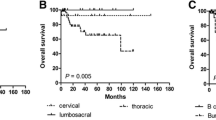Abstract
Purpose
Evaluation of risk factors for survival in patients surgically treated for symptomatic spinal epidural metastases (SEM).
Methods
One hundred and six patients who were surgically treated for symptomatic SEM in a 10-year period in two cooperatively working hospitals were retrospectively studied for nine risk factors: age, gender, site of the primary tumor, location of the symptomatic spinal metastasis, functional and neurologic status, the presence of visceral metastases and the presence of other spinal and extraspinal bone metastases. Analysis was performed using the Kaplan–Meier method, univariate log-rank tests and Cox-regression models.
Results
Overall median survival was 10.7 months (0.2–107.5 months). Overall 30-day complication rate was 33 %. Multivariate Cox-regression analysis showed that fast growing primary tumors (HR 3.1, 95 % CI 1.6–6.2, p = 0.001), the presence of visceral metastases (HR 1.7, 95 % CI 1.0–2.9, p = 0.033) and a low performance status (HR 2.7, 95 % CI 1.1–6.6, p = 0.025) negatively influenced the survival.
Conclusion
Primary tumor type, presence of visceral metastases and performance status are significant predictors for survival after surgery for symptomatic SEM and should be evaluated before deciding on the extent of treatment. More accurate prediction models are needed to select the best treatment option for the individual patient.




Similar content being viewed by others
References
Quan GMY, Vital J-M, Aurouer N, Obeid I, Palussiere J, Diallo A et al (2011) Surgery improves pain, function and quality of life in patients with spinal metastases: a prospective study on 118 patients. Eur Spine J 20(11):1970–1978
Patchell RA, Tibbs PA, Regine WF, Payne R, Saris S, Kryscio RJ et al (2005) Direct decompressive surgical resection in the treatment of spinal cord compression caused by metastatic cancer: a randomised trial. Lancet 366(9486):643–648
Jansson K-A, Bauer HCF (2006) Survival, complications and outcome in 282 patients operated for neurological deficit due to thoracic or lumbar spinal metastases. Eur Spine J 15(2):196–202
Tokuhashi Y, Matsuzaki H, Toriyama S, Kawano H, Ohsaka S (1990) Scoring system for the preoperative evaluation of metastatic spine tumor prognosis. Spine 15(11):1110–1113
Tokuhashi Y, Matsuzaki H, Oda H, Oshima M, Ryu J (2005) A revised scoring system for preoperative evaluation of metastatic spine tumor prognosis. Spine 30(19):2186–2191
Tomita K, Kawahara N, Kobayashi T, Yoshida A, Murakami H, Akamaru T (2001) Surgical strategy for spinal metastases. Spine 26(3):298–306
van der Linden YM, Dijkstra SPDS, Vonk EJA, Marijnen CAM, Leer JWH, Dutch Bone Metastasis Study Group (2005) Prediction of survival in patients with metastases in the spinal column: results based on a randomized trial of radiotherapy. Cancer 103(2):320–328
Bauer HCF, Wedin R (1995) Survival after surgery for spinal and extremity metastases: prognostication in 241 patients. Informa UK Ltd, UK
Karnofsky D (1967) Clinical evaluation of anticancer drugs: cancer chemotherapy. Gann Monograph 2:223–231
Schag CC, Heinrich RL, Ganz PA (1984) Karnofsky performance status revisited: reliability, validity, and guidelines. J Clin Oncol 2(3):187–193
Frankel HL, Hancock DO, Hyslop G, Melzak J, Michaelis LS, Ungar GH et al (1969) The value of postural reduction in the initial management of closed injuries of the spine with paraplegia and tetraplegia. Spinal Cord 7(3):179–192
Wibmer C, Leithner A, Hofmann G, Clar H, Kapitan M, Berghold A et al (2011) Survival analysis of 254 patients after manifestation of spinal metastases—evaluation of seven preoperative scoring systems. Spine 36(23):1977–1989
Rades D, Douglas S, Veninga T, Stalpers LJA, Bajrovic A, Rudat V et al (2012) Prognostic factors in a series of 504 breast cancer patients with metastatic spinal cord compression. Strahlenther Onkol 188:340–345
Yamashita T, Siemionow KB, Mroz TE, Podichetty V, Lieberman IH (2011) A prospective analysis of prognostic factors in patients with spinal metastases: use of the revised Tokuhashi score. Spine 36(11):910–917
Crnalic S, Hildingsson C, Wikström P, Bergh A, Löfvenberg R, Widmark A (2011) Outcome after surgery for metastatic spinal cord compression in 54 patients with prostate cancer. Acta Orthop 83(1):80–86
Chow E, Harth T, Hruby G, Finkelstein J, Wu J, Danjoux C (2001) How accurate are physicians’ clinical predictions of survival and the available prognostic tools in estimating survival times in terminally ill cancer patients? A systematic review. Clin Oncol (R Coll Radiol) 13(3):209–218
Pointillart V, Vital J-M, Salmi R, Diallo A, Quan GM (2011) Survival prognostic factors and clinical outcomes in patients with spinal metastases. J Cancer Res Clin Oncol 137(5):849–856
Chi JH, Gokaslan Z, McCormick P, Tibbs PA, Kryscio RJ, Patchell RA (2009) Selecting treatment for patients with malignant epidural spinal cord compression—does age matter? Results from a randomized clinical trial. Spine 34(5):431–435
Tancioni F, Navarria P, Pessina F, Attuati L, Mancosu P, Alloisio M et al (2012) Assessment of prognostic factors in patients with metastatic epidural spinal cord compression (MESCC) from solid tumor after surgery plus radiotherapy: a single institution experience. Eur Spine J. [Epub ahead of print]
Acknowledgments
The authors would like to thank D.J. Lobatto and W.S.F.J. Tummers for their invaluable support in creating the database.
Conflict of interest
None of the authors have a conflict of interest to declare.
Author information
Authors and Affiliations
Corresponding author
Additional information
Part of the Leiden—The Hague Spinal Intervention Prognostic Study (SIPS) group.
Appendix
Appendix
If a risk factor is divided into more than two categories, pairwise grouped analysis was performed using log-rank tests. Data presented are p values. For each category, number of patients and median survival in months with 95 % confidence interval is given (see Tables 8, 9, 10, 11, 12, 13, 14, 15, 16).
Rights and permissions
About this article
Cite this article
Bollen, L., de Ruiter, G.C.W., Pondaag, W. et al. Risk factors for survival of 106 surgically treated patients with symptomatic spinal epidural metastases. Eur Spine J 22, 1408–1416 (2013). https://doi.org/10.1007/s00586-013-2726-4
Received:
Revised:
Accepted:
Published:
Issue Date:
DOI: https://doi.org/10.1007/s00586-013-2726-4




